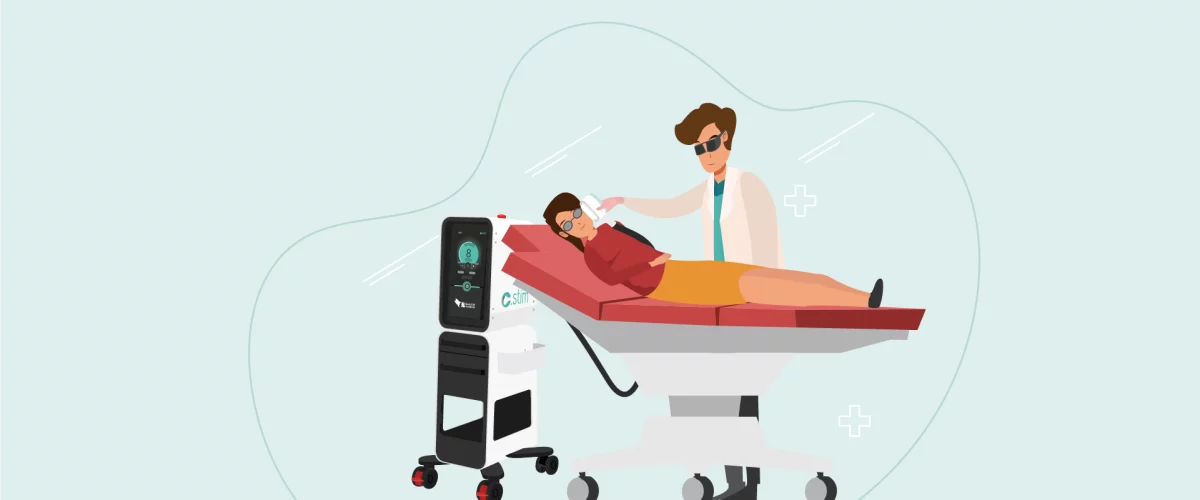Intense pulsed light (IPL) to treat dry eyes
Dry eye disease affects millions worldwide, causing discomfort, and a persistent gritty sensation. Traditional treatments like artificial tears and warm compresses often provide limited relief. However, a cutting-edge therapy is changing how we approach chronic dry eye: Intense Pulsed Light (IPL).
This article explores how IPL treatment works, its safety, efficacy, treatment protocol, and what to expect during consultation —helping you decide if this innovative approach is right for you.
IPL for dry eyes treatment
What is intense pulsed light (IPL) treatment?
Intense Pulsed Light (IPL) is a non-invasive treatment that uses pulses of broad-spectrum light to target inflammation, eliminate Demodex mites and improve the function of the meibomian glands, which are responsible for producing the oily layer of your tears. When these glands become blocked or dysfunctional—a common cause of evaporative dry eye—IPL helps to restore their function and break the cycle of inflammation.
Originally developed for dermatological conditions such as rosacea, IPL has now been successfully adapted for use in ophthalmology. Unlike other treatments, the IPL therapy addresses one of the root causes of dry eye disease rather than only relieve symptoms.
Emerging evidence also suggests that IPL may help reduce neuropathic ocular pain in some patients, offering additional relief beyond surface-level symptoms.
How does IPL treatment work for dry eyes?
IPL treatment relieves symptoms by addressing irritation and improving meibomian gland function. The light pulses gently heat the skin under the eyes, melting blocked oil in the glands and restoring the tear film’s lipid layer—reducing tear evaporation.
IPL also treats abnormal blood vessels and inflammation around the eyelids, especially in rosacea patients, where skin and ocular symptoms are often linked. By reducing redness and vascular congestion, IPL breaks the vicious cycle of inflammation.
Patients typically experience a gradual improvement in symptoms such as:
- Dry eye sensation
- Burning and stinging sensations
- Fluctuating or blurry vision
- Eye redness and irritation
- Foreign body sensation
This multifactorial approach is what makes IPL treatment a game-changer for many patients.
IPL safety and efficacy for dry eyes
Is IPL dry eye treatment safe?
Yes, IPL treatment for dry eyes is widely recognized as a safe and well-established procedure when performed by trained specialists using approved medical devices. Its safety profile is supported by multiple clinical studies and years of use in ophthalmology. The technology is precise, non-invasive, and specifically designed to target the causes of meibomian gland dysfunction and ocular inflammation without harming surrounding tissues.
Because IPL does not involve surgery or internal medication, it offers a low-risk alternative for managing chronic dry eye—especially in patients who haven’t responded well to conventional treatments.
For optimal results, it’s important to consult an experienced dry eye specialist who can tailor the procedure to your specific needs and ensure it’s used appropriately.
Can IPL damage vision?
When performed properly, IPL for dry eyes does not damage vision. The light pulses are directed at the skin below the eyes, avoiding direct exposure to the cornea or retina. Safety protocols require the use of eye shields to protect ocular structures, if the flashes are made on the eyelids.
In fact, by improving tears stability, meibomian glands and reducing ocular surface irritation, many patients report clearer vision and enhanced comfort after treatment.
Are there any contraindications to IPL treatment?
Yes, certain conditions may make IPL treatment unsuitable for some patients. These include:
- Injured, burnt or infected skinin the treatment area
- Exposure to artificial UV radiation, or use of a self-tan product within the last two weeks
- Consultation with a dermatologist is necessary in case of medical history of the face: cancer, vitiligo, psoriasis, lupus erythematosus, keloid
- Photo-sensitising treatment in progress
- History of sun hypersensitivity
- Very dark skin tones due to increased risk of pigmentation changes
- C.STIM IPL system: Suitable for Fitzpatrick skin types I to V, offering safe and effective treatment for darker tones.
- Other IPL systems: May have limited technical capabilities, allowing only restricted use on skin types I to IV due to higher risk of adverse effects.
- Pregnancy or breastfeeding (due to limited clinical data)
A thorough evaluation by an eye care professional is essential to determine whether IPL therapy is appropriate based on your medical history, skin type, and specific dry eye profile.
Durability of IPL treatment for dry eyes
How long does IPL for dry eye take to work?
Many patients begin noticing symptom relief after the first or second session. However, optimal results typically occur after a full series of treatments—usually 3 to 4 sessions spaced about 2 to 4 weeks apart.
The cumulative effect of the treatment optimize meibomian gland function, decreases inflammation, and enhances tear film quality over time.
How long do IPL results last?
Results from IPL treatment can last anywhere from 6 to 12 months and mor2, depending on the severity of your dry eye condition and ongoing environmental or lifestyle factors.
To maintain relief, some patients benefit from occasional maintenance appointment every 6 to 12 months. Your eye care provider will guide you on a personalized follow-up plan based on your response to treatment.
What is the IPL treatment protocol?
How many IPL sessions are needed to treat dry eyes?
Most IPL protocols involve a series of 3 to 4 sessions, each lasting around 10-15 minutes. These sessions are usually spaced 2–4 weeks apart. This timeline allows for gradual improvement in gland function and sustained relief from dry eye symptoms.
In some cases, additional round may be recommended depending on how your eyelid and meibomian glands respond. A personalized approach ensures the treatment is tailored to your specific needs.
How does an IPL session work?
Here’s what to expect during an IPL procedure:
- Preparation: The person is seated in a reclining chair. A gel is applied to the periocular area toenhance light transmission into the skin, improve treatment effectiveness and ensure greater comfort during the procedure.
- Eye Protection: Specialized eye shields are placed over the eyes to block light exposure.
- Light Pulses: The practitioner takes a handheld IPL device to deliver pulses of light to the targeted skin areas. The feeling is often described as a warm sensation or a light snapping feeling.
- Post-treatment Care: The gel is removed, and mild moisturizers or sunscreen may be applied. Patients can typically return to normal activities immediately.
It’s non-invasive, quick, and well-tolerated by most people.
How much does dry eye IPL cost?
The cost of IPL treatment for dry eyes can vary depending on the clinic, geographic location, and the number of sessions required. On average, each appointment typically ranges from $50to $300, with most patients needing a series of 3 to 4 sessions for optimal results.
IPL treatment is usually not covered by public health insurance. However, some private insurance providers may reimburse part of the cost. Additionally, some clinics offer treatment packages or financing options to make the therapy more accessible.
While the upfront cost may seem significant, many individuals find it to be a worthwhile investment—especially when other treatments fail to provide lasting relief. This treatment addresses the root cause of dry eye disease, potentially reducing long-term spending on symptom management.
Dry eye specialist: Diagnosis & Treatment
A successful journey starts with an accurate diagnosis. We understand that every dry eye patient is unique. That’s why we’ve created the “Find a Specialist” tool—your gateway to expert care.
Using this feature, you can locate qualified eye care professionals in your area who are experienced in:
- Meibomian gland dysfunction
- Intense Pulsed Light therapy
- Ocular surface disease
- Dry eye diagnostics and imaging
Working with a knowledgeable specialist ensures you receive a customized treatment plan that maximizes the benefits of IPL while ensuring safety and efficacy.




